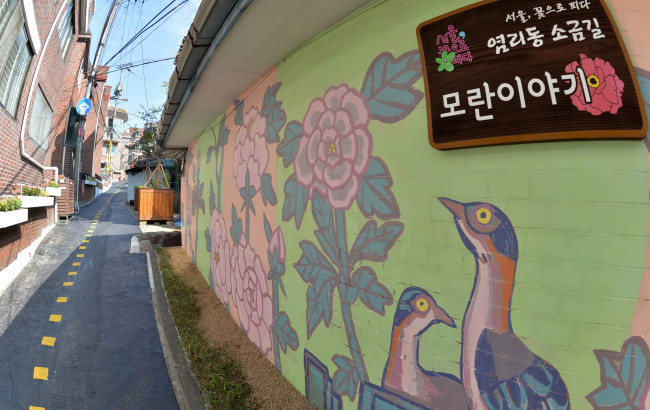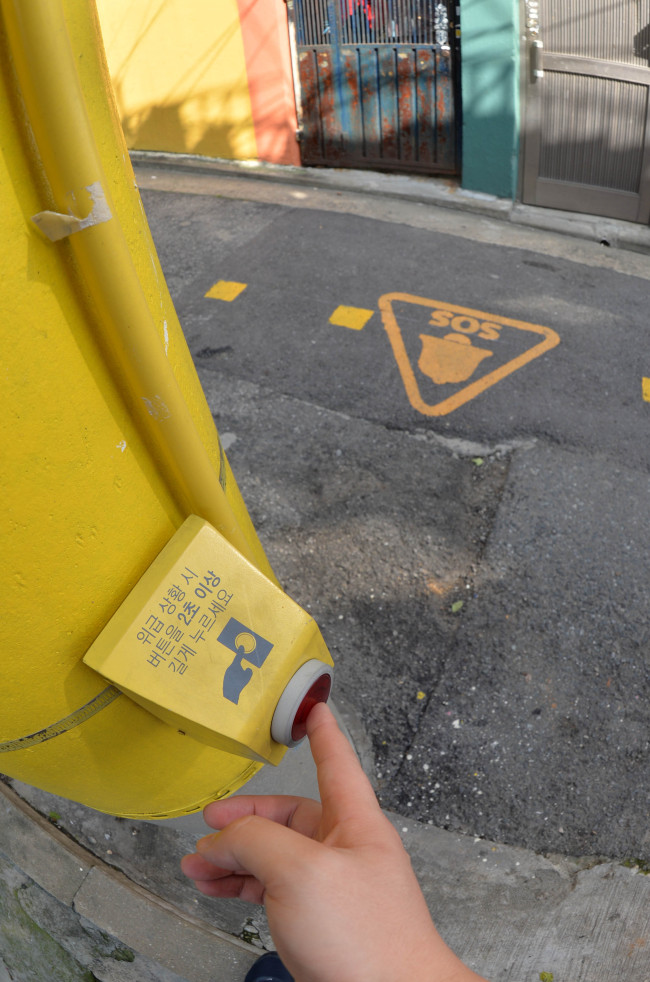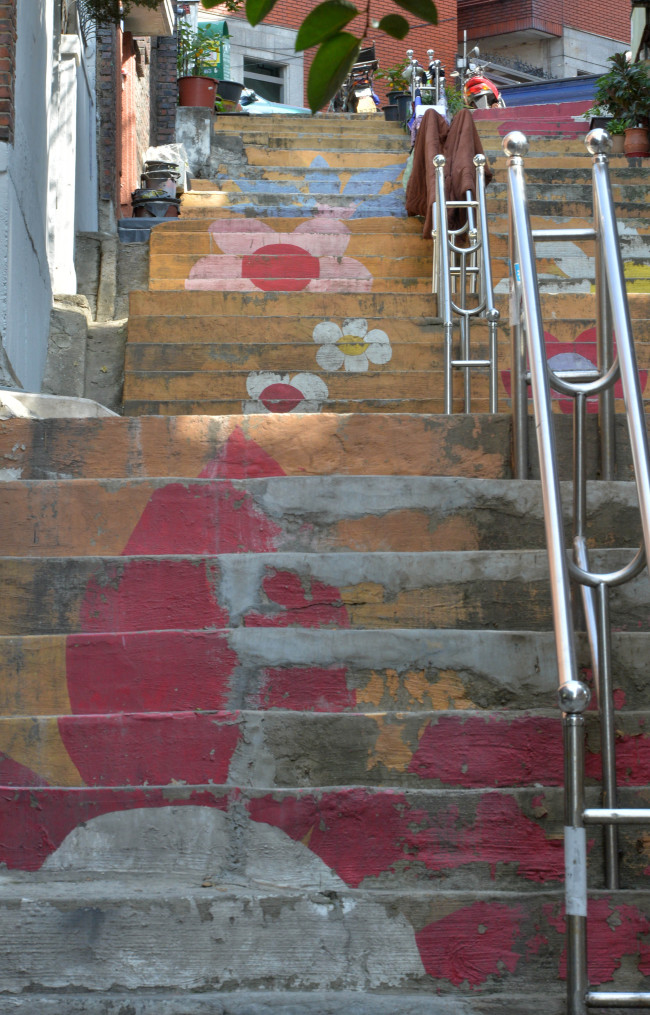From Sogeumgil to Gamcheon village, design revives culture, life in neighborhood
 |
|
Murals greet people on the Sogeumgil trail. (Lee Sang-sub/The Korea Herald) |
This is the last installment in an eight-part series that examines the social role of design beyond its aesthetic aspect. ― Ed.
In Yeomni-dong of Mapo District in Seoul, near Ewha Womans University, is the 1.7-kilometer walking trail of “Sogeumgil (salt way).”
Unlike its vibrant college area neighbor, Yeomni-dong is filled with crooked and narrow alleys, some too small to fit two people.
The walking course is tough, with steep stairways and slopes. Large sign posts painted in yellow line the maze-like alleys and there are six houses whose doors are painted in yellow with the word, “emergency.” Some might complain that the route is too tough for a leisurely stroll.
But Sogeumgil is more than a walking trail. The trail, which residents explain can take more than an hour to complete, was actually designed to tighten security in the neighborhood. It has, in fact, become the best example of crime prevention through public design.
Yeomni-dong hasn’t been the most favored of areas in Seoul. After decades of dispute between the government, local community and businessmen over redevelopment plans, many people left, with the remaining residents forming something of a shantytown.
While the majority of the residents were elderly people and women, the narrow and dark streets were without surveillance cameras or monitoring to ensure safety.
“Before, it was very, very dark. I have lived here for three decades but even I felt uneasy walking outside at night. Fathers would pick up their grownup daughters at bus stops or subway stations,” said a woman who only identified herself by her last name Kim, who runs a supermarket in the neighborhood.
In November last year, small changes were made. The Seoul Metropolitan Government joined hands with local residents in renovating the area.
Instead of warning people about crime, the authorities and local community leaders decided to attract more traffic. The narrowest slopes were redesigned into walking courses with signs with light-hearted messages such as “Where you can have slender thighs,” “Where you can stretch your arms for leaner forearms,” “Contemplation spot” and “Healing spot.”
On the steep stairs are markings showing the number of calories that could be burned by climbing them. To allow children enjoy their neighborhood, they painted hopscotch squares on the ground. The 69 LED lights with yellow signboards and surveillance cameras gave people a sense of security while Salt Cafe, run by the residents, became a hotspot filled with locals sharing neighborhood gossip and visitors.
And as people visited to walk the trail, crime went down. According to the local government, emergency 112 calls to police from the area dropped 30 percent after the renovation. Moreover, locals’ satisfaction rate marked 83.3 percent.
“In fact I enjoy walking the trail whenever I have time now,” Kim said.
The story of Sogeumgil has inspired other local governments struggling with similar problems. From Jangan District of Suwon in Gyeonggi Province to South Chungcheong Province and Jeju, more than 19 local governments have reportedly set out to benchmark the success of Yeomni-dong. Seoul City is rumored to be planning to allocate 15 billion won for similar projects around the capital city.
 |
|
An emergency button is installed on an utility pole at Sogeumgil, Yeomni-dong, Seoul. (Lee Sang-sub/The Korea Herald) |
Sogeumgil has also raised awareness of public design.
So far, public design, aimed at adding aesthetic elements to public scenes or facilities. has been led by the government. Ko Young-lan, a Hansung University professor, however, suggests public design is more than that. She says that public design is something that can bring the whole community together by involving them ― from the design stage to letting them take over the management and maintenance.
“Sogeumgil was made successful only with the local residents’ help and support. It was possible because the designers truly understood the problem and really cared to come up with the right solution,” she said.
Bonding with locals
In fact, it was the residents who gladly offered the walls of their houses to be painted yellow and even painted the walls of their houses in bright colors to banish dullness elsewhere. They brought out flower pots and removed dirt and garbage from their doorsteps voluntarily.
Hong Seong-taek, leader of the Yeomni-dong Community, said the process of creating public design had formed friendships in the neighborhood and made the place a much better space.
“We brought out our stuff, painted and cleaned the alleys and said hello to each other, made friends. It was design that started this at first but it was friendship that solidified the project. And with a tighter bond formed around the community, the monitoring has been reinforced and the area has naturally become safer,” he said.
From dereliction to public gallery
The Samtan Art Mine is another example of how a derelict area can be turned into a favorite visiting spot.
The Korea Public Design Award 2013 winner is situated in the now-closed Jeongam coal mine in Samcheok, Gangwon Province. The mine, which closed in 2001, was slowly becoming derelict and the locals were worried about their area succumbing to urban decay, said Kim Min-seok, operator of the project.
Thanks to the government’s development plans for 150 defunct mines in the country, the Samtan Art Mine Project opened in 2011 with 100,000 art pieces collected from more than 150 countries around the world.
The developers decided to keep the exposed concrete and the chilly atmosphere of the old structure. The gray cement and concrete contrast with colorful pieces of art. The doors and some walls have been torn down to create a larger space while pipelines and valves have been exposed on the ceiling.
A logo designed in the shape of the building as well as black and red signs are installed everywhere, creating a visual identity as well.
“We have come up with an original story. First, it is the mining of the place: It was the place of coal, often referred to as black gold, and now will be the mine of passion of artists,” Kim Min-suk said.
“Secondly, we will mine memories: In the past people flocked here dreaming of hitting the jackpot. Even after their departure. the space is filled with their traces. Therefore, the closed mine is not dead. It is a place where we can discover potential memories and create new events. Third, we will mine people. It takes 200 million years for coal to form and miners are the ones that dig up 200 million years of history. We will discover their stories. We will travel in time to their era and listen to them,” he added.
“The great thing about the project was that it transformed the place to a place locals can enjoy instead of establishing ‘coal museums.’ We also believe that the project brushed off the negative image of nearby areas where there is Kangwon Land, the only casino in Korea that allows Korean nationals,” said Seo Yong-gil, an official at the Ministry of Culture, Sports and Tourism, which gives out the public design award.
“Also, it tried to maintain the original building and even recycled the old machines into lighting tools. It was the perfect reformation of a space,” he said.
“It wasn’t the easiest project but the authorities as well as the local community were supportive in bringing a breath of fresh air to the village,” Kim said.
Sustainability
 |
|
Stairways are painted in the design street of Sogeumgil, Yeomni-dong, Seoul. (Lee Sang-sub/The Korea Herald) |
Samtan is not the only unsightly public space that has been given a facelift under the concept of public design. The famous Gamcheon Village of Busan was transformed after nearly all of its walls were colorfully painted and alleys decorated with cute caricatures, shedding its dull image.
The five-day workweek has also fueled local government efforts to attract tourists. Design experts, however, warn that sustainability should a key consideration.
“One of the key points of public design is whether it is sustainable. How long can paint on a village wall last? Who will repaint it? Will local residents be willing to take part? All these elements should be considered before pushing ahead with ‘flashy ideas,’” said professor Ko.
“Go with the locals and listen to their voices. That’s what public design is all about.”
By Bae Ji-sook (baejisook@heraldcorp.com)